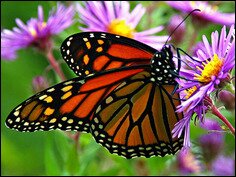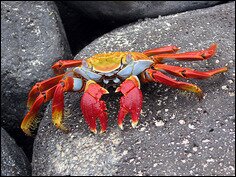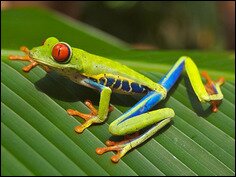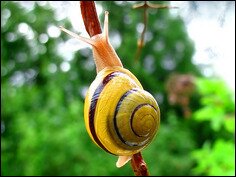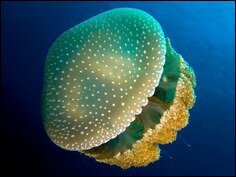Miscellaneous Animals
Current Category: Miscellaneous.
These four types of animals have some interesting ways of catching their foods and eating them that are a bit different to the rest of the animal kingdom. These animals have found innovative ways in which to get nourishing chemical compounds from the outside world to their insides, which ultimately, is all we need to do. Well, as well as get the compounds we don’t need out again, of course.
 Australian spotted jellyfish or also known as white-spotted jellyfish (Phyllorhiza punctata). © Nick Hobgood and Papa Lima Whiskey.
Australian spotted jellyfish or also known as white-spotted jellyfish (Phyllorhiza punctata). © Nick Hobgood and Papa Lima Whiskey.
Jellyfish
Most jellyfish go with the flow – literally. Most of the 200 species drift around and wait for food to come to them. When the jellyfish’s prey animals, often plankton or small fish, get tangled up in their tentacles, the tentacles inject a poison into the animal that either stuns or kills it. The food is then transferred to the jellyfish’s single-pouch gut, where it is digested. The jellyfish takes in food with its mouth, and it also expels waste from it once digestion is done. Larger jellyfish will hunt and grab prey as it passes, and most of these larger creatures prefer crustaceans.
 4 examples of phytoplankton. Illustration by Robert Simmon, NASA Earth Observatory.
4 examples of phytoplankton. Illustration by Robert Simmon, NASA Earth Observatory.
Plankton
There are four types of plankton, bacterial, zooplankton, archaea and phytoplankton. Bacterioplankton and archaea consume organic material left behind by other animals. They are also capable of chemosynthesis and photosynthesis. Zooplankton are tiny animals, crustaceans and arthropods that can feed on bacterioplankton, phytoplankton and larger animals. Phytoplankton are the smallest type, and this type makes its living by photosynthesis. Phytoplankton is the basis of the marine food chain. We need phytoplankton.
 A crown-of-thorns starfish eating a coral. Pic by .
A crown-of-thorns starfish eating a coral. Pic by .
Starfish
Starfish have two stomachs, a cardiac stomach and an internal pyloric stomach, where digestion takes place. The cardiac stomach can be pushed out through the mouth, which is found on the bottom of the starfish, so that it surrounds its prey and sucks it back into the starfish’s body. Starfish have primitive eyes on the ends of their arms, and they use them to locate small prey animals like small fish, plankton and bivalves. Other species eat decomposing plant or animal material.
Worms
Worms are deposit feeders and detritus eaters. Lovely. They take in soil and decomposing plant or animal material in one end, take out what they need as it passes through, and excrete the remainder out of the other. It sounds very simple, but we need worms like earthworms, as their poo is nitrogen rich and their burrowing and pooing mixes the soil up, oxygenating it.
Continue reading: Miscellaneous animal food chain.



